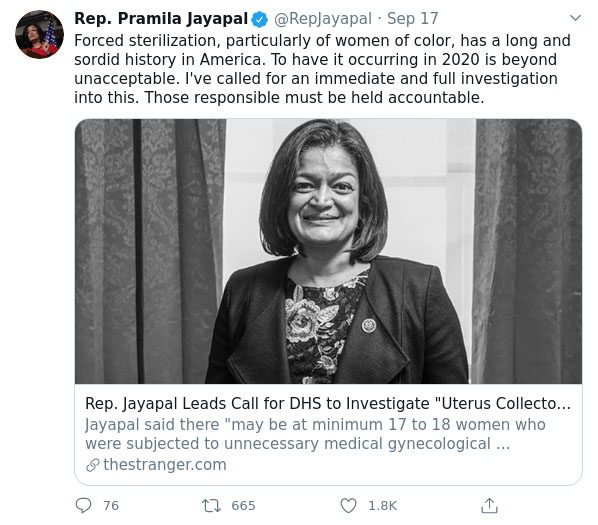To The Teacher:
In this lesson, students learn about recent news related to forced sterilization as well as the history of forced sterilization and eugenics, then research and discuss aspects of this issue.
Note: This lesson explores controversial and disturbing aspects of American history. Before you begin the lesson, consider how students may react and how you can ensure a supportive classroom climate for the group discussion. You may want to review these guidelines on teaching about controversial or difficult issues.
For more background on this subject, see the articles below, as well as the sources listing at the end of this lesson.
https://theintercept.com/2020/09/17/forced-sterilization-ice-us-history/
https://time.com/5737080/native-american-sterilization-history/
Introduction
Share with students the following tweet:

Ask students:
- What does this tweet refer to?
- What is “forced sterilization”?
Share with students some of the information below:
In September 2020, Dawn Wooten, a Georgia nurse, filed a whistleblower complaint alleging that immigrant women detained at the Irwin Country Detention Center in Ocilla, Georgia, were receiving a high number of hysterectomies. (A hysterectomy removes a woman’s uterus, preventing her from having a child.)
House immigration subcommittee member Rep. Pramila Jayapal later spoke with an attorney representing the women, who said that approximately 18 women at the center had been subjected to unnecessary gynecological procedures they didn’t consent to. Rep. Jayapal sent a letter to the Department of Homeland Security, signed by 173 other members of Congress, requesting an investigation of what had happened at the facility.
Forced sterilization has a long history, some of which is just now being acknowledged and discussed. In the United States, forced sterilization is rooted in the “eugenics movement” that peaked in the 1920s and 1930s. In theory, eugenicists advocated for eliminating reproduction in people considered unfit, specifically those with physical and mental disabilities. In practice, states began forced sterilization programs targeting people of color, women immigrants, poor people as well as people with physical and mental disabilities.
In June 2019, the University of Vermont issued an apology for the forced sterilizations that resulted from the Vermont Eugenics Survey program it operated, in conjunction with the State of Vermont, from 1925 to 1936.The university now offers an online database detailing the history of the eugenics movement in all 50 states.
A Short History of Eugenics and Forced Sterilization
Share with students these 12 slides, which provide historical context on eugenics.
Read the slides with students, and discuss any questions that surface.
Note: Slide number 10 discusses the case of Elaine Riddick, a North Carolina woman who, as a teenager, was raped and impregnated and, after birthing her son, was forcibly sterilized. It includes a link to a 4-minute videotaped statement by Riddick about her experience. Consider playing the video for students and inviting their responses.
The video is here: https://www.youtube.com/watch?v=cFJNX5bHYVI
Independent Work
Next, ask students to work in pairs to find out more about the history of the eugenics movement by delving into the University of Vermont’s database detailing this history in all 50 states. (Students may choose a state, or assign states for students to research.)
Database location: http://www.uvm.edu/~lkaelber/eugenics/
After they’ve read the information, ask each pair of students to discuss the following questions:
- What precipitated lawmakers in this state to pass sterilization laws?
- Who was targeted by the laws?
- What arguments could you make for or against sterilization laws?
- What do the passage of these laws and the continued use of forced sterilizations say about us a society?
Next, reconvene students as a group and discuss the United States’ history of forced sterilizations.
If students are interested in exploring this issue further, or want to take action on it, invite them to research the organizations that are working to ensure reproductive justice. Some of them are listed below.
Closing
Ask students to share one thing that surprised them in their research or in the discussions.
Source Documents
“Sterilization Operations Performed in California Mental Hospitals and Institutions for Mental Defectives, to June 30, 1941,” in the Statistical Report of the Department of Institutions of the State of California (Sacramento: California State Printing Office, 1941):
Effects of Eugenic Sterilization As Practiced In California: A 1920s source document distributed by the Human Betterment Foundation in Pasadena, CA
https://www.ncbi.nlm.nih.gov/pmc/articles/PMC1449330/figure/f1/?report=objectonly
Immigration Detention and Coerced Sterilization: History Tragically Repeats Itself
https://www.aclu.org/news/immigrants-rights/immigration-detention-and-coerced-sterilization-history-tragically-repeats-itself/
Rep. Jayapal’s letter to Homeland Security
http://jayapal.house.gov/wp-content/uploads/2020/09/DHS-IG-FINAL.pdf
Women’s History Review: Informing Red Power and Transforming the Second Wave: Native American women and the struggle against coerced sterilization in the 1970s
https://www.tandfonline.com/doi/abs/10.1080/09612025.2015.1083229 scroll=top&needAccess=true&journalCode=rwhr20
University of Michigan Archive on Birthing Reproductive Justice
https://apps.lib.umich.edu/online-exhibits/exhibits/show/reproductive-justice/overview/anticipating-reproductive-just
University of Vermont Apology
https://www.sevendaysvt.com/OffMessage/archives/2019/06/21/uvm-apologizes-for-a-eugenics-survey-that-ended-in-1936
Groups organizing to stop forced sterilization:
Latina Institute for Reproductive Justice: https://www.latinainstitute.org/ (@LatinaInstitute)
Sistersong: https://www.sistersong.net/reproductive-justice (@SisterSong_WOC)
Project South: https://projectsouth.org/ (@ProjectSouth)
Black Alliance for Just Immigration: https://baji.org/ (@BAJItweet)
National Black Women’s Reproductive Justice Agenda : https://blackrj.org/ (@BlackWomensRJ)
Unite for Reproductive & Gender Equity: https://urge.org/ (@URGE_org)